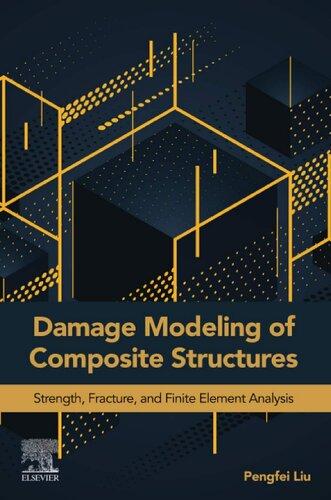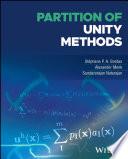Visit to download the full and correct content document: https://ebookmass.com/product/static-and-dynamic-analysis-of-engineering-structures -incorporating-the-boundary-element-method-levon-g-petrosian/
More products digital (pdf, epub, mobi) instant download maybe you interests ...
The Inclusion-Based Boundary Element Method (iBEM)
Huiming Yin
https://ebookmass.com/product/the-inclusion-based-boundaryelement-method-ibem-huiming-yin/
Damage Modeling of Composite Structures: Strength, Fracture, and Finite Element Analysis 1st Edition
Pengfei Liu
https://ebookmass.com/product/damage-modeling-of-compositestructures-strength-fracture-and-finite-element-analysis-1stedition-pengfei-liu/
Elements of Numerical Mathematical Economics with Excel: static and dynamic optimization. Romeo
https://ebookmass.com/product/elements-of-numerical-mathematicaleconomics-with-excel-static-and-dynamic-optimization-romeo/
Finite Element Method: Physics and Solution Methods
Sinan Muftu
https://ebookmass.com/product/finite-element-method-physics-andsolution-methods-sinan-muftu/
Partition of Unity Methods: The Extended Finite Element Method St¿Phane Bordas
https://ebookmass.com/product/partition-of-unity-methods-theextended-finite-element-method-stphane-bordas/
Introduction to the Finite Element Method 4E 4th Edition Reddy
https://ebookmass.com/product/introduction-to-the-finite-elementmethod-4e-4th-edition-reddy/
Engineering Economic Analysis 14th Edition Donald G. Newnan
https://ebookmass.com/product/engineering-economic-analysis-14thedition-donald-g-newnan/
A First Course in the Finite Element Method 6 Enhanced SI Edition Daryl L. Logan
https://ebookmass.com/product/a-first-course-in-the-finiteelement-method-6-enhanced-si-edition-daryl-l-logan/
Reaction Mechanisms in Environmental Engineering. Analysis and Prediction James G. Speight
https://ebookmass.com/product/reaction-mechanisms-inenvironmental-engineering-analysis-and-prediction-james-gspeight/
StaticandDynamic AnalysisofEngineering Structures StaticandDynamic AnalysisofEngineering Structures IncorporatingtheBoundary ElementMethod LevonG.Petrosian
WashingtonDistrictDepartmentofTransportation,USA
VladimirA.Ambartsumian
StructuralEngineeringandStructuralMechanics
ArmenianNationalUniversityofArchitecture&Construction,Armenia
Thiseditionfirstpublished2020 ©2020JohnWiley&SonsLtd
Allrightsreserved.Nopartofthispublicationmaybereproduced,storedinaretrievalsystem,ortransmitted,in anyformorbyanymeans,electronic,mechanical,photocopying,recordingorotherwise,exceptaspermittedby law.Adviceonhowtoobtainpermissiontoreusematerialfromthistitleisavailableat http://www.wiley.com/go/permissions.
TherightofLevonG.PetrosianandVladimirA.Ambartsumiantobeidentifiedastheauthorsofthisworkhas beenassertedinaccordancewithlaw.
RegisteredOffices
JohnWiley&Sons,Inc.,111RiverStreet,Hoboken,NJ07030,USA
JohnWiley&SonsLtd,TheAtrium,SouthernGate,Chichester,WestSussex,PO198SQ,UK
EditorialOffice
TheAtrium,SouthernGate,Chichester,WestSussex,PO198SQ,UK
Fordetailsofourglobaleditorialoffices,customerservices,andmoreinformationaboutWileyproductsvisitusat www.wiley.com.
Wileyalsopublishesitsbooksinavarietyofelectronicformatsandbyprint-on-demand.Somecontentthat appearsinstandardprintversionsofthisbookmaynotbeavailableinotherformats.
LimitofLiability/DisclaimerofWarranty
Inviewofongoingresearch,equipmentmodifications,changesingovernmentalregulations,andtheconstantflow ofinformationrelatingtotheuseofexperimentalreagents,equipment,anddevices,thereaderisurgedtoreview andevaluatetheinformationprovidedinthepackageinsertorinstructionsforeachchemical,pieceofequipment, reagent,ordevicefor,amongotherthings,anychangesintheinstructionsorindicationofusageandforadded warningsandprecautions.Whilethepublisherandauthorshaveusedtheirbesteffortsinpreparingthiswork,they makenorepresentationsorwarrantieswithrespecttotheaccuracyorcompletenessofthecontentsofthiswork andspecificallydisclaimallwarranties,includingwithoutlimitationanyimpliedwarrantiesofmerchantabilityor fitnessforaparticularpurpose.Nowarrantymaybecreatedorextendedbysalesrepresentatives,writtensales materialsorpromotionalstatementsforthiswork.Thefactthatanorganization,website,orproductisreferredto inthisworkasacitationand/orpotentialsourceoffurtherinformationdoesnotmeanthatthepublisherand authorsendorsetheinformationorservicestheorganization,website,orproductmayprovideorrecommendations itmaymake.Thisworkissoldwiththeunderstandingthatthepublisherisnotengagedinrenderingprofessional services.Theadviceandstrategiescontainedhereinmaynotbesuitableforyoursituation.Youshouldconsultwith aspecialistwhereappropriate.Further,readersshouldbeawarethatwebsiteslistedinthisworkmayhavechanged ordisappearedbetweenwhenthisworkwaswrittenandwhenitisread.Neitherthepublishernorauthorsshallbe liableforanylossofprofitoranyothercommercialdamages,includingbutnotlimitedtospecial,incidental, consequential,orotherdamages.
LibraryofCongressCataloging-in-PublicationData
Names:Petrosian,LevonG.(LevonGregory),1-author.| Ambartsumian,V.A.(VladimirAlexander),author.
Title:Staticanddynamicanalysisofengineeringstructures: incorporatingtheboundaryelementmethod/LevonG.Petrosian, ProfessorofStructuralEngineeringandStructuralMechanics, WashingtonDistrictDepartmentofTransportation,USA VladimirA.Ambartsumian,ProfessorofStructuralEngineeringandStructuralMechanics, ArmenianNationalUniversityofArchitecture&Construction,Armenia
Description:Firstedition.|Hoboken,NJ:JohnWiley&Sons,Inc.,2020. |Includesbibliographicalreferencesandindex.
Identifiers:LCCN2019034987(print)|LCCN2019034988(ebook)|ISBN 9781119592839(hardback)|ISBN9781119592884(adobepdf)|ISBN 9781119592938(epub)
Subjects:LCSH:Structuralanalysis(Engineering)–Mathematics.|Boundary elementmethods.
Classification:LCCTA640.P482020(print)|LCCTA640(ebook)|DDC 624.1/7–dc23
LCrecordavailableathttps://lccn.loc.gov/2019034987
LCebookrecordavailableathttps://lccn.loc.gov/2019034988
CoverDesign:Wiley
CoverImage:©aaaaimages/GettyImages
Setin11.5/14ptSTIXTwoTextbySPiGlobal,Chennai,India
PrintedandboundbyCPIGroup(UK)Ltd,Croydon,CR04YY
InMemoryof myTeacher,Mentor,andFriend ALEXANDERIZRAELEVICHTSEITLIN (1933–2011)
DoctorofTechnicalScience,Professor, MemberoftheRussian&InternationalEngineering AcademyofScience
AbouttheAuthorsxi Prefacexiii Introductionxv
Chapter1: MethodsofDynamicDesignofStructuralElements1
1.1TheMethodofSeparationVariables1
1.2TheVariationalMethods7
1.3IntegralEquationsandIntegralTransformsMethods11
1.4TheFiniteElementMethod17
1.5TheFiniteDifferenceMethod25
1.6TheGeneralizedMethodofIntegralTransformation27
1.7TheMethodofDelta-Transform44
1.8TheGeneralizedFunctionsinStructuralMechanics63
1.9GeneralApproachestoConstructingBoundaryEquations,and StandardizedFormofBoundaryValueProblems67
1.10TheRelationshipofGreen’sFunctionwithHomogeneousSolutions oftheMethodofInitialParameters80
1.11TheSpectralMethodofBoundaryElements83
1.12TheCompensateLoadsMethod89
Chapter2: BoundaryElementsMethods(BEM)inthe MultidimensionalProblems93
2.1TheIntegralEquationsofBoundaryElementsMethods93
2.2TheConstructionofBoundaryEquationsbytheDelta-Transformation Technique103
2.3TheEquivalenceofDirectandIndirectBEM114
2.4TheSpectralMethodofBoundaryElements(SMBE)inMultidimensional Problems118
2.5TheProblemsDescribedbytheIntegro-DifferentialSystemof Equations124
Chapter3: OscillationofBarsandArches131
3.1TheNonlinearOscillationsofSystemswithOneDegreeofFreedom131
3.2TheNonlinearOscillationsofSystemswithMultiple-Degrees-of-Freedom141
3.3TheNonlinearOscillationsofSystemswithDistributedMass154
3.3.1SimplySupportedBeams156
3.3.2BeamsWithBuilt-inEnds157
3.3.3BeamsWithOneEndHingedSupportandAnotherEnd Built-inSupport157
3.3.4TheCantileverBeam158
3.4TheOscillationsoftheBeamoftheVariableCross-sections161
3.5TheOptimumDesignoftheBar167
3.6TheOscillationsofFlexural-Shifted(Bending-Shifted)BarsUnderthe SeismicImpacts170
3.7OscillationsofCircularRingsandArches176
3.8TheFreeOscillationsofSystem“FlexibleArch-RigidBeam”182
3.9TheResultsofDynamicTestingModelofCombinedSystemRigid-beam andFlexibleArch195
3.10TheOscillationsoftheCombinedSystemTakingintoAccountitsExtent ataGivenHarmonicMotionBase207
3.11TheDeterminationoftheReactionsofMultipleSpansFrameBridges, ExtendedBuildings,andStructuresTakingintoAccounttheInitialPhase ofPassing(Propagation)oftheSeismicWave224
Chapter4: OscillationofPlatesandShells243
4.1TheDesignoftheCantileverPlateofMinimalMassWorkingontheShift withtheAssignedFundamentalFrequency243
4.2TheExperimentalandTheoreticalResearchofOscillationofaCantilever PlatewithRectangularOpenings254
4.3TheOscillations(Vibrations)ofSphericalShells262
4.4TheApplicationoftheSpectralMethodofBoundaryElement(SMBE)to theOscillationofthePlatesonElasticFoundation265
Chapter5: ThePropagationofElasticWavesandTheirInteraction withtheEngineeringStructures271
5.1ThePropagationofSeismicWavesintheLaminarInhomogeneous Medium271
5.2DiffractionofHorizontalWavesontheSemi-cylindricalBase ofStructure277
5.3MethodofCalculationoftheLiningofTunnelstoSeismic Resistance285
5.4AStudyoftheActionofSeismicWaveontheRigidRingLocated intheHalf-plane298
5.5CalculationsofUndergroundStructureswithArbitraryCross-section underSeismicActionImpact306
Chapter6: TheSpecialFeaturesoftheSolutionofDynamicProblems bytheBoundaryElementMethods(BEM)315
6.1OneMethodofCalculation:TheHilbertTransformanditsApplications totheAnalysisofDynamicSystem315
6.2ConstructionofGreen’sFunctionforBasesHavingFrequency-Dependent InternalFriction324
6.3TheGreen’sFunctionsofSystemswiththeFrequency-Independent InternalFriction332
6.4TheNumericalRealizationofBoundaryElementMethod(BEM)342
6.5TheConstructionoftheGreen’sFunctionoftheDynamicStationary ProblemfortheElasto-ViscousHalf-Plane351
Chapter7: TheQuestionsoftheStaticandDynamicAnalysisof StructuresonanElasticFoundation365
7.1TheKerneloftheGeneralizedModelofElasticFoundation(Base)378
7.2TheDeterminationoftheCharacteristicsoftheGeneralized(Unified, Integrated)ModeloftheElasticFoundation(Base)393
7.3ContactProblemfortheRigidDie,LyingontheGeneralized ElasticBase397
7.4OnOneMethodofCalculationofStructuresonanElastic Foundation404
7.5TheCalculationofthe(Non-isolated)BeamsandPlates,Lyingonan ElasticFoundation,DescribedbytheGeneralizedModel408
7.6TheForcedOscillationsofaRectangularPlateonanElastic Foundation415
7.7TheCalculationoftheMembraneofArbitraryShapeonanElastic Foundation428
AppendixA: CertificateofEssentialBuildingData443
AppendixB: ContactStressesontheSoleoftheCircularDieandthe SoleofthePlaneDie455
B.1ContactStressesontheSoleoftheCircularDie.455
B.2ContactStressesontheSoleofthePlaneDie.457
References459 Index483
AbouttheAuthors LevonG.PetrosianisaProfessorofStructuralEngineeringandStructural Mechanics.HereceivedhisB.S.andM.S.degreesfromtheArmenian NationalUniversityofArchitecture&Construction.HereceivedaPh.D.from theMoscowStateUniversityofCivilEngineering(MGSU)andthedegree ofDoctorofTechnicalSciencefromtheMoscowResearchCenterofConstruction,ResearchInstituteofBuildingStructures(TSNIISK).Dr.Petrosian istheauthorofmorethan60scientificworksandpublications,including monographsandtextbooks.Hehasbeenassociatedwithtransportationand structuralengineeringindustriesforover40yearsasaresearchengineer andscientist.PriortohismovetotheUnitedStates,Dr.Petrosianwasthe ChairmanofDepartmentofStructuralMechanicsattheArmenianNational UniversityofArchitecture&ConstructionaswellastheExecutiveDirector andtheHeadoftheArmenianEarthquakeEngineeringResearchInstitute. Currently,Dr.PetrosianservesastheChiefofthePlanReviewDivisionat theDistrictofColumbiaDepartmentofTransportation.
VladimirA.Ambartsumian,ProfessorofStructuralEngineeringand StructuralMechanicsreceivedB.S.,M.S.,Ph.D.,andthedegreeofDoctorof TechnicalSciencefromtheArmenianNationalUniversityofArchitecture& Construction.HewasaProfessorofStructuralMechanicsattheArmenian NationalUniversityofArchitecture&Construction.Heauthoredand co-authorednumerousscientificpublications.
Preface Thisbookpresentsbothmethodologicalandpracticalpurposesofstatic anddynamicanalysisofengineeringstructures.Therefore,accountingof allmethodsisaccompaniedbythesolutionofthespecificproblems,which notonlyareillustrativematerial,butalsomayrepresentindependent interestinthestudyofvarioustechnicalissues.Itprovidesanoverview andapplicationsofallmodernaswellaswell-knownclassicmethodsof calculationofvariousstructuremechanicsproblemsinoneplace.
Thebookgeneralizesallexistingclassicalandmodernmethodsof calculationsofengineeringproblemsandstructuralmechanicsproblems overthespanofthelast50years.Throughcomprehensiveanalysis,the bookshowsanalyticalandmechanicalrelationshipsbetweenclassicaland modernmethodsofsolvingboundaryvalueproblems.
Thebookfeaturesextensiveuseofthegeneralizedfunctionsfordescribingtheimpactsonstructures,andsubstantiationsofthemethodsofthe apparatusofthegeneralizedfunctions.
Thebookillustratesthemodernmethodsofstaticanddynamicanalysisofstructuresandthemethodsforsolvingboundaryvalueproblemsof structuralmechanicsandsoilmechanics.
Thebookincludesexamplesofsolvingdifferentproblemsofstaticand dynamiccalculationofbeams,plates,shells,multi-bodysystems,regular structures,bridgestructures,andundergroundconstructions.
Thebookprovidesawidespectrumofapplicationsofmoderntechnics andmethodsofcalculationofstatic,dynamic,andseismicproblemsofengineeringdesign.
Thebookshowswhichmethodsandtechniquesshouldbeusedforspecificandcomplexproblems.Thesemethodsaremosteffectiveforsolving deferentproblemsofstaticanddynamicanalysisofstructures.
Finally,thebookpresentsanewmodelofacohesiveelasticbasecovering awiderangeofpropertiesofrealsoils.Thelimitingcasesofthemodelare theWinklerbaseandtheisotropicelastichalf-space.
Thebookprovidesnumeroussolutionsofvariousstaticanddynamic problemsofthetheoryofelasticity.
LevonG.Petrosian ProfessorofStructuralEngineeringandStructuralMechanics DepartmentofTransportation
Introduction Theclassicalmethodsofstructuralmechanicswidelyusedforstaticand dynamicdesignofstructures,inparticularthemethodsofforceand displacement/deformation,arebasedonverytransparentmechanical representationsassociatedwiththereplacementofagivenstructureto someother,moreconvenienttocalculate“primarysystem,”thatisloaded insuchawaythattheentireprimarysystemoroneofitspartsisturnedinto agiven.Inthetheoryofelasticityandinmathematicalphysicsasimilar methodofsolvingtheboundary-valueproblemsisusedandconsidered classical;themethodofpotential.Whenapplyingthismethod,theassigned domainisactuallysubstitutedbysomeunlimiteddomain,loadedwith someadditionalload,suchthatthesolutioninthegivendomainand chosenunlimiteddomain(analogofprimarysystem)areidentical.The reasonforchoosingtheprimarysysteminaformofunlimiteddomain, forwhichsolutionsofthecorrespondingboundary-valueproblemsare constructed,hasproventobeverysuccessfulandhasfounddevelopmentin suchengineeringmethodsasthemethodofcompensatingloads,extended domains,andboundaryelements,aswellasinpurelymathematical methodsofgeneralizedsolutions(GSMs),boundaryintegralequations, anddelta-transforms.Fromthelistedmethods,whichhaveprogressedin therecentyears,thegreatestdevelopmentwasobtainedinthemethodof boundaryintegralequationswiththediscretenessoftheboundary,also
calledthemethodofboundaryelementbytheanalogywiththeknown finiteelementmethod(FEM).TodayFEMisthemaintoolofcalculations andanalysisofconstructionindesignandresearchpractice.Methods oftheBoundaryElementMethod(BEM)typehaveprovedtobevery effectivetosuccessfullycompeteinplane(two-dimensional)andspatial (three–dimensional)problemswithFEMandFiniteDifferenceMethod (FDM),sincetheydonotrequirediscretenessoftheentiredomain,butonly itsboundary.Thisleadstoper-unitreductionofthedimensionalityofa problemwithmoreeffectivecomputationalalgorithms.Anotheradvantage oftheBEMistheabilitytosolveproblemsinunlimiteddomains,which isparamountforthedynamicsofconstructions,soilmechanics,andother areasofthetheoryofelasticityandstructuralmechanics.
Inthisbook,alongwiththegeneralapproachtotheconstruction ofboundaryequationsofdifferenttypes,twonewmethodsareapplied; DeltaTransformationMethodandSpectralMethodofBoundaryElements(SMBEs)whichmakeobtainingeffectivesolutionsofvarious boundary-valueproblemsofstructuralmechanicspossible.Application ofthemethodsisillustratedbysolvinganumberofproblemsinthe calculationofstructuresonstaticanddynamicimpacts.
Contemporarystructuralmechanicsandtheoriesofconstruction investigatestressesonmanyobjects,calculationofwhichisassociated withthesolutionofboundary-valueproblemsfordifferentialoperators. Inthiscase,incontrasttotheclassicalproblemsofmathematicalphysics, theboundary-valueproblemsofstructuralmechanicshavehigherorder andmorecomplexstructures.Therefore,bothgeneralmethodsofsolving differentialandintegralequations,andspecificengineeringmethodspurely basedonmechanicalperformancesarewidelyused.Inthisbookwewill examinethemethodsofsolvingboundary-valueproblems;typicalforstructuralmechanicsandrelatedfields.Allofthesemethods,whiledifferentin form,canbeunitedbyonebasicprocedure–theIntegralTransform,which iseitheranintegralpartofthemethoditself,orisusedforitssubstantiation orconclusion.Inthemoderntechnicalandphysicalliterature,theMethod ofIntegralTransformsispresentedinessenceasapparatusconnectedwith theuseofclassicalFouriertransform,Laplace,Melina,Hankel,aswellas thetransformsofKantorovich-Lebedev,Meler-Fock,andothers.Eachof thetransformsisobtainedwithinacomparativelyclearlyoutlinedfieldof application.
Atthesametime,thevarietyofproblemswhichareencountered inthevarioussectionsofsciencecannotbesolvedonlywiththeaidof
traditionalintegraltransforms.Therefore,furtherdevelopmentofthe methodofintegraltransformsshouldproceedinthedirectionofexpanding thequantityofpracticalsuitablekernels,andgeneralizationandnecessary applicationofthemethodsofconstructingthekernelsoftransforms.This bookpresentsageneralapproachtothemethodofintegraltransforms basedonthespectraltheoryofthelineardifferentialoperators,andprovides newtransformswhichwillaidusinsolvingvariousproblemsrelevantto bars,beams,plates,andshells,inparticular.
Anotherequallyimportanttaskistoshowthecloserelationshipofintegraltransformswithdifferentmodernmethodsandwithtypesofpotentials; inparticular,withthemethodofdelta-transform(A.I.Tseitlin[370]),which maybethebasisforamathematicalfoundationofmanymethodsofstructuralmechanics.
Thebookpursuesbothmethodologicalandpracticalpurposes,andthe accountingofallmethodsisaccompaniedbysolutionsofthespecificproblems,whicharenotmerelyillustrativeinnature,butmayrepresentindependentinterestinstudyofvarioustechnicalissues.Twospecialfeatures ofthebookareanextensiveuseofthegeneralizedfunctionsfordescribing theimpactsonstructuresandsubstantiationsofthemethodsoftheapparatusofthegeneralizedfunctions.Instructuralmechanicsthetheoryofthe generalizedfunctionsdoesnotyetapplyasthoroughlyasinothersections ofmechanicsandphysics.Inthisbookitisshownthatthetheoryofgeneralizedfunctionsallowsustoobtainbroadgeneralizationsoftheclassical methodsofstructuralmechanics,tosimplifysolutionsofmanyproblems, andidentifytherelationshipsamongthemethods.
Thisbookillustratesthemodernmethodsofstaticanddynamicanalysis ofstructuresandthemethodsforsolvingboundary-valueproblemsofstructuralmechanicsandsoilmechanicsbasedontheapplicationofboundary equations.Thesystemswithnon-linearandvariableelasticcharacteristics areexamined.Thefundamentalsofthegeneraltheoryofoscillationsare considered.Examplesofsolvingdifferentproblemsofstaticanddynamic calculationofbeams,plates,shells,multi-bodysystems,regularstructures, bridgestructures,undergroundconstructions,andstructuresonanelastic foundationaregivenaccordingtothemethodspresentedinthebook.The bookalsoanalyzestheimpactofseismicinfluencesonregularstructures.
Further,thebookoffersamethodofphysicalrealizationofthedynamic systemsbasedontheexamplesofanelastic-viscousfoundationwithinternal friction.Theinternalfrictioninthefoundationisdescribedbythemodels ofKelvin-VoigtandSorokin.
Chapter1showsthemainmethodsusedinthedynamicanalysisofbars, plates,andshells.Historically,oneofthefirstmethodsofsolvingequations ofmathematicalphysicsisthemethodofseparationofvariables.Theapplicationofthismethodisdescribedintheexamplesofsolvingproblemsof freeoscillationofrectangularandcircularmembranes.
Therangeofproblemswhichcanbesolvedaccuratelyinaclosedform islimited,andtherefore,thereareoftenvariationalmethodsusedinpractice.Theapplicationoftwovariationalmethods–theRayleigh-Ritzmethod andtheGalerkinmethodareshownintheexamplesofthetransverseoscillationsofbars.Theuseofintegralequations,inparticularthereduction ofproblemswithoscillationofone-dimensionalstructurestotheintegral equationsofVolterraofthesecondkindandFredholmofthesecondkind, aredemonstrated.Themethodsusedfornumericalsolutionsofproblemsof dynamicsaredescribed.ThesearetheFEMandFDM.IneithertheFEMor FDMthewholedomainofthepartialdifferentialequations(PDEs)requires discretization.TheFEMispresentedinanexampleofaplaneproblemof thetheoryofelasticity.Adiagramofsolvingaproblemofnon-stationary oscillationsofacantileverplateisshown.Theoscillationsofacompressed bararesolvedusingtheFDM.
TheBEMoriginatedfromtheworkscarriedoutbyseveralresearch groupsduringthe1960sintheapplicationofboundaryintegralequations forthesolutionofengineeringproblems.Theseresearcherswerelooking foradifferentsolutionfromtheFEMwhichwasstartingtobecomemore widelyestablishedforcomputationalanalysisofstructuralmechanics problems.
TheBoundaryIntegralEquationsMethod(BIEM)isgenerallyfoundin themethodsofTheoryofPotentialandBoundaryIntegralEquations,but thebasicfeaturesandideaofthemethodofboundaryequationscanbe alsofoundintheclassicalmethodsofstructuralmechanicsthathavedevelopedconsiderablyearlierthanthecorrespondingmethodsofmathematical physics.BIEMinstructuralmechanicswereknowninthewesterncountries throughtheworkofformerSovietUnionresearchersandscientistssuchas N.I.Muskelishvili,S.G.Miklin,V.D.Kupradze,V.Z.Parton,P.I.Perlin,G.J. Popov,A.I.Tseitlin,andY.V.Veryuzhsky.Atthattimethesemethodswere consideredtobedifficulttoimplementnumerically.
Successfulapproachesofstructuralmechanicstothecalculationof complexsystemsbyreplacingthemwithsimplersystemsandmaking themmoreaccessibleforcalculationscarriedallsignsoftheMethodsof BoundaryEquations.Sincestructuralmechanicsinitiallydevelopedmainly
asascienceofbarsystems,theapplicationofsuchclassicalmethodsas methodsofforce,displacement,ormixedmethodledtotheboundary equationsinadiscretesetofjoints.
Thus,asarule,auxiliarytasksforwhichone-dimensionalanaloguesof Green’sfunction–aunitreactionandunitdisplacement,weredetermined andcorrespondedtoelementsofthesystem(e.g.thehorizontalandvertical elementsoftheframe),sothattheconstructionofauxiliaryconditions wasassociatedwiththenarrowingofthedomaintoseveralsub-domains. Thefirstone-dimensionalanaloguesoftheBEMappearedinstructural mechanicswithanintroductionofinfinitesystems,whichinitiatedthe CompensatingLoadsMethod(CLM),Extended-DomainMethod(EDM), andBEM,aswellasinpurelymathematicalmethodsofGSM,BIEM,and theDelta-TransformMethod(DTM).Amongthesemethodsdevelopedin recentdecades,themostdevelopedisthemethodofBoundaryIntegral Equationswiththediscretizationoftheboundary,alsoknownasthe BEM.BEMissimilartothemethodoffiniteelements,whichisnowthe majorinstrumentforactualcalculationsandanalysisofstructuresinthe designandresearchpractice.TheBEMisatechniqueforsolvingarangeof engineeringandphysicalproblems.TheheartoftheBEMtechniqueliesin theintegralequationformulationforagivenboundaryvalueproblem.The mathematicalbasisofthisapproach,ofcourse,isclassicalGreen’sfunction, andasmentionedearlieritcorrespondswiththeinfluencefunctionof structuralmechanics.TheBEMhasthedistinctioninandadvantageof thefactthatonlythesurfacesofthedomainneedtobemeshed.Methods suchasboundaryelementshaveprovedtobeveryeffective,andthey successfullycompeteintwoandthree-dimensionalproblemswiththe (FEM)andthe(FDM),becauseunlikethesemethods,BEMdoesnot requiresampling(discreteness)oftheentirearea,butonlyitsborder,which decreasesdimensionoftheproblembyoneunitandleadstomoreefficient computingalgorithms.TheadvantagesintheBEMarisefromthefact thatonlytheboundaryorboundariesofthedomainofthePDEsrequire sub-divisiontoproduceasurfaceorboundarymesh.
AnotheradvantageofBEMisapossibilityofsolvingproblemsinan unboundeddomain,whichisveryimportantforthestructuraldynamics, soilmechanics,andotherfieldsofthetheoryofelasticityandstructural mechanics.
ThisbookdescribesbothageneralapproachtotheconstructionofvarioustypesofboundaryequationsandaspectralBEM,whichallowsusto obtaineffectivesolutionsofvariousboundaryvalueproblemsofstructural
mechanics.TheapplicationofSMBEisillustratedbysolvinganumberof problemsonthestructuralanalysisofthedesignofconstructiononthestatic anddynamicimpacts.
Theissueoftheequivalenceofboundaryandinitialvalueproblems withtheinhomogeneityintheboundary(initial)conditionsandtheright sideoftheequationinrespecttothedesignofstructuresonthestaticand dynamicloadsareconsidered.Thisbookshowsa“standard”formofthe problem,obtainedbyusingthedeltatransformandallowingreplacement oftheboundaryorinitialconditionsbyacertaincorrespondingloadon thestructuresintheformofadelta-functionanditsderivatives.The constructionofthe“standard”formisillustratedonthesimplestexamples oftheboundaryvalueproblemforbeamsandtheCauchyproblemforthe systemwithonedegreeoffreedom.
ThereisageneralschemeforsolvingtheproblemsofthetheoryofelasticitybytheCLMinthefirstchapter.
Chapter2examinestheapplicationofBEMinthemultidimensional problems.TheintegralequationsofBEMareconsidered;constructionofthe boundaryequationsusingthemethodofdelta-transformisgiven;andthree basicschemesforconstructingboundaryintegralequationsusingtheDTM areanalyzed.Simpleproofofthecompleteequivalenceoftwobasicversions ofBEM–directandindirect–isgiven.TheSMBE,basedonexpansion ofdifferentialoperatorsconsideringintheextendeddomainisproposed. Inparticular,forthispurposetheFourierandHankeltransforms,aswell asexpansionofbeamfunctionswidelyusedinstructuralmechanicscan beused.Problemsdescribedbytheintegro-differentialsystemofequations areexamined.Asanexample,acontactproblemforaplanestructurewith stress-strainedconditionsinacertaindomainisdescribedbyalineardifferentialoperator,somegivenboundaryconditions,andcontactconditions withalinear-deformedmedium.
Chapter3outlinestheissuesofvibrationsofbars,arches,andcombined systems.Thefreenonlinearvibrationsystemswithoneandmanydegrees offreedom,andthesystemswithdistributedmassatvariousdependencies oftherestoringforcefrommovingareexamined.Thevaluesoftheperiods offreevibrationareobtainedbyvariousmethods,suchasdirectintegration oftheequationsofmotionandtheuseofasymptoticmethods.
Astudyoffreevibrationsofabeamwithanarbitrarylawofvariationof thecrosssectionisalsodiscussedinthethirdchapter.Classicalresultsfor theoscillationproblemsofacantileverbeamofminimummassareshown. Theoutlinedsolutionshavespecificapplicationsinthedynamicstructural
analysis.Inparticular,thechaptershowstheapplicationofthesolutionof theproblemofforcedoscillationsoftheshiftedflexural-cantileverbeam undertheseismicanalysisofthestructures.
Alongwiththestudyoftheoscillationsofelementswithastraightaxis, theoscillationsofcurvilinearelements,inparticularcirculararchesand rings,arealsoexamined.TheseincludetheequationofoscillationsofS.P. Timoshenkoforcirculararchesandrings,aswellassomesimpleresultson valuesofnaturalfrequenciesoftheseelements.
Thethirdchapterfurtherdescribesfreevibrationsofcombinedsystems suchas“rigidbeam-flexiblearch”consideringthedynamicthrustwhenthe axisofthearchisoutlinedbyasquareparabolaandacirculararch.
Thechaptershowsanexperimentally-theoreticalmethodforcalculating thecombinedsystemstakingintoaccountthejointdynamicworkofthe basicspantoadjacentbridgetrestlesusingthefactor“increasing”frequency. Weshowamethodforseismicanalysisofcombinedsystemswithregard totheirlengthusingrealseismogramsofpowerfulearthquakes.Thereare generalequationsofmotionforasystemwithafinitenumberofdegreesof freedominaspatialdeformationstructures.
Chapter4isdevotedtothevibrationsofplatesandshells.Weshowthe optimumdesignoftheshearcantileverplate.Theminimumofthetotal massoftheplateisconsideredastheoptimalitycriterion.Theproblemis solvedconsideringthelimitationofthethicknessoftheplate.
Thischaptergivestheexperimentalresultsoffreevibrationofcantilever plateswithrectangularholes.Wealsoshowasatisfactorymatchbetweenthe resultsoftheoreticalcalculationsandtheexperiment,andpresenttheasymmetricvibrationsofthinelasticsphericalshellsandequationsfordeterminingthefrequencyofahemispherewithfreeends.
TheapplicationoftheSMBEtotheoscillationoftheplatesonanelastic foundationisexamined.InparticularaspectralBEMtotheoscillationsor freevibrationofplateofarbitraryshapelyingonWinklerianfoundationand beingunderaloadisprovided.
Chapter5examinesissuesofelasticwavesspreadandtheirinteraction withengineeringstructures.Thechapterexaminestheproblemofpropagationofelasticwavesininhomogeneouslayeredmediumandanalyzescases ofchangeofshearmodulusandthedensityoftheexponentialandpower law.Thischaptersolvestheproblemofinteractionsofelasticwaveswitha semi-cylindricalbasestructures.Theissuesofinteractionofseismicwaves onthetunnelliningareexamined.Anapproachtothestudyofstressaround acircularlining,locatednearthesurfaceofthehalf-space,isoutlined.The
chapterproposesamethodforstudyingthedynamicstressesaffectingthe cross-sectionlining.Numericalresultsarestated.
Chapter6describesfeaturesofsolvingdynamicmethodsofboundaryequations.Itisknownthatmostbuildingmaterialshavedamping properties,characterizedbythefrequency’sindependentloss.However, thereisacertaindependencyofdampingparameters(coefficientsloss, decrement)onthefrequencyofthedeformationforsoilsintheexperiments.Frequency-dependentlossesaretypicalforanumberofmodern materials,suchascertainplastics.Itistherefore,averyimportanttaskto describethedynamicbehaviorofsoilandstructuralmaterialspossessing bothfrequency-independentandfrequency-dependentinternalfriction. Wediscussthetypesofproblemsinrelationtotheconstructionofthe Greenfunctionforthecorrespondingenvironment.Fromthetheoryof dynamicsystems,itfollowsthatbetweentherealandimaginarypartsofthe transmissionfunctionofthecasualsystem,certainintegraldependencies whichdefinetheformulasofHilberttransform,mustexist.Thischapter presentsanewwayofcalculationofHilberttransformthroughFourier transformationofcorrespondingfunctions,whichsimplifiestheproblem, duetoextensiveFouriertransformstables.Thepresentedmethodof calculatingtheHilberttransformallowstocomparativelyeasilyanalyze theaprioristicmodelsofthedynamicsystemsbasedonthecreationof complexrigidityorcomplexpliabilityofsystem.Thismethodmakesit possibletoanalyticallydetermineoneofthecomponentsofthecomplex rigidityinaccordancewiththeexperimentallydefinedothercomponent.A fewexamplesofthecalculationoftheHilberttransformofdelta-functions, Heavisidefunction,andapowerfunctionareexamined.
Theabove-describedmethodofcalculatingtheHilberttransform isappliedtotheanalysisofdynamicmodelsbasesofinternalfriction, describedbythehypothesisofVoigt,Sorokin,andSchlippe-Boc.Further, constructionofGreen’sfunctionfortheunlimitedplate,whichlieson Winkleriantypeelasto-viscousbasewiththearbitrarydependenceofthe parametersofthecomplexcoefficientofbedonthefrequencyisexamined. Theimportance,fromapracticalpointofview,ofthetaskonoscillations ofthesystemwithonedegreeoffreedom,whoseelastic-viscousproperties (parameters)dependonfrequencyofoscillations,isconsidered.
ThequestionofconstructionoftheGreen’sfunctionforonedimensionaldynamicalsystemswithdampingdescribedbydifferent modelfrequency-independentandfrequency-dependentinternalfriction isexamined.Weexaminestationaryone-dimensionalwavetasks,based
onanexampleofthelongitudinalfreevibrationsoftheisotropicuniform unlimitedbarwithunitharmonicloadinthecentralsectionorthe lateraloscillationsofstring.Thefollowingbasicmodelsofmediumare investigated:
1.commonlinearmodel;
2.elastic-viscousmodelofVoigt;and 3.themodelofthefrequency-independentelastic-viscousresistance.
TheconstructionoftheGreen’sfunctionforthenon-stationary transversefreevibrationofabarandplatetakingintoaccountthe frequency-independentelastic-viscousresistanceisconsidered.AnumericalrealizationofadirectBEMforthesolutionofplanestationaryproblems ofthelineartheoryofelasticity,takingintoaccounttheinternalfriction,is presented.
Anurgentproblemofstructuralmechanics,connectedinparticular, withthedevelopmentandimprovementoffoundationengineering,amajor trendintheconstructionbusiness,isthetheoryofanalysisofstructures onelasticfoundation.Thistheoryprovidesforreliabilityandefficiencyof someofthemostpopularandimportantstructures,suchas;foundationsof buildings,roadandairportpaving,coatingslopesofhydraulicstructures, dams,baselayersoffloorsofindustrialbuildings,powerfloorsoftestcases, andmore.
Improvingthemethodsofanalysisofstructuresbasedonactualsoil propertiesisoneofthemajorhurdlesincreatingamoreefficientandreliabledesignsolution,andpreventingundesirableconsequencesinconstructiononweakandsubsidingsoils,andinseismicallyactiveareasnearminingandblasting.ThisproblemhasbecomeverysignificantafterthedevastatingearthquakesinArmenia,China,Chili,Italy,Japan,Haiti,Pakistan, andPhilippinesinconnectionwithlarge-scalereconstructionworkandthe revaluationintensitiesofaseismicallyactivezone.
Chapter7isdevotedtothestaticanddynamicanalysisofstructures onelasticfoundation.Descriptionofanewmodelofcohesiveelasticfoundation,coveringawiderangeofpropertiesofrealsoils,isexamined.The limitingcasesforthismodelaretheWinklerfoundationandisotropicelastichalf-space.Theproposedmodel,alongwiththeversatility,hasseveral advantagesovertheearthfoundationmodelscurrentlyappliedinpractical calculations.Inparticular,underaconcentratedloadthemodelgivesthe finaldisplacementsandstresses,allowsforjumpsofdisplacementsonthe surfaceofthebase,anddoesnotresultinendlessmovementsolutionsof
planeproblems.Theproposedmodelhassolvedanumberofproblemsinthe analysisofstructuresontheelasticfoundation,suchas;membranes,hard foundation,barebeams,andslabs;andfreeoscillationsofrectangularfoundationslabsarealsoexamined.Thischaptershowstechniquesfordeterminingthemodelparametersundertheresultsofexperimentalstudiesofsoils.
TheapplicationofSMBEtothecalculationofstructuresontheelastic foundationisfurtherexamined.Theequilibriumofthemembrane,bendof thenon-isolatedbeamsandplateswiththefreeends,lyingonthebasiswith theproposedbasekernel,areexamined.
Thenumericalsolutionofcontacttaskfortheplaneandaxisymmetrical (axisymmetric)rigiddie,whichrestsonthebasiswiththeproposedkernelandanewiterationtechniqueforsolvingcontactproblems,aregiven. Theproposedgeneralizedmodelofelasticfoundationduetotheregularityofitskernelpavesthewayfortheapplicationofeffectivemethodsof solvingcontactproblemsandproblemsofdesignstructuresonelasticfoundation,associatedwithdifferentwaysofdirectlyreducingtheformulated problemtothesolutionoftheintegralequationofFredholmofthesecond kind.Theeffectivenessofthismethodisdeterminedbytheabilitytoapply asimpleiterativeprocedureforobtainingthemostimportantcharacteristic(variable)–contactpressure.Thenthecalculationofstructurescanbe producedwiththecombinedactionofexternalloadandobtainedcontact pressure.Toillustratethemethodofcalculationasolutiontotheproblemof thebendingofthebeamoffinitelength,freelyingontheelasticfoundation, describedbythegeneralizedmodelisgiven.
Theauthorsoffermethodsandapplications(notalwaysasimpletask consideringboundary-valueproblems),inasufficientlysimpleandclear wayinordertomakeiteasilyaccessibleforreaderswithmathematicaland technicalbackgroundatuniversitylevel.However,forcomprehensionofthe book,initialknowledgeinsuchareasofmathematicsasthetheoryofthe generalizedfunctions,transforms,andtheoryoflinearintegralequations, isnecessary.Thespecifiedmathematicalapparatusinrecentdecadeshas widelypenetratedthetechnicalsciences,especiallystructuralmechanics, andknowledgeableandsophisticatedreadersshouldbefamiliarwithit. Withintheframeworkofthelimitedsizeofthispublication,dedicationwas madetoemphasizeBEMcalculationsofconstructions,howeveritisnotpossibletoillustrateallaspectsoftherapidlydevelopingareasofBEM.Oneof thepurposesofthispublicationistofamiliarizethereaderswiththedifferentmethodsofbuildingtheboundaryequations,includingthosebasedon theorthogonalexpansionsthatleadtotheboundaryalgebraicequations.
Thetechniquesofsolvingboundaryintegralequations,thechoiceof boundaryelements,approximationoffunctions,etc.remainbeyondthe scopeofthiswork.Thereaderswhoareinterestedintheseissuesshould pursuemonographsandnumerousarticlesbyM.H.Aliabadi,P.K.Banerjee, R.Butterfield,C.A.Brebbia,S.Walker,T.A.Cruse,F.J.Rizzo,P.Fedelinski, S.Hirose,S.Mellings,V.Z.Parton,P.I.Perlin,U.V.Veryuzhsky,J.O.Watson, andothers.
Thebookisintendedmainlyforprofessionalsandspecialistsinthefield ofstructuralmechanicsandrelatedareas.Inpreparingthebook,theauthors triedtomakeitaccessiblenotonlyforscientists,researchers,andgraduate studentsinthefieldofstructuralmechanicsandrelatedareas,butalsofor engineersworkingindesigncentersandorganizations.
Intheappendixtothebookprintoutsaregivenoftheprogramsof solutionofcontactproblemforthebasewiththeregularkernel,andtables ofthecontactstressesobtainedwithsolutionofplaneandaxisymmetrical (axisymmetric)contactproblems.
Additionally,thebookcanserveasaguideforstudentsoftechnical collegesinthestudyoftherelevantsectionsforthecourseofstructural mechanics.
ThisbookwaswrittenincollaborationwithDr.Ambartsumian,who passedawayseveralyearspriortoitscompletionandpublication.Iwould liketoacknowledgehiscontributiontothismonographandhisdedication toscienceandresearch.
Iwishtotakethisopportunitytoexpressmyappreciationtomyformerteachersandcolleagueswhoovertheyearshavesograciouslyadvised andencourageddiscussionsthatledtopreparationofthistext.Inparticular,IgratefullyacknowledgeindebtednesstoprofessorsA.I.Tseitlin,A.R. Rzhanitsin,B.G.Korenev,N.N.Leontiev,V.I.Travush,D.N.Sobolev,A.A. Babloyan,V.A.Ilichev,E.E.Khachiyan,M.A.Dashevsky,V.A.Smirnov,and A.W.Taylor.
Iwouldespeciallyliketothankmywife,Natalie,andmydaughters, GalinaandIrina,fortheirsupport,patienceandlove.
Finally,IwanttothankJohnWileyandSonsInc.andthestafffor theireffectivecooperationandtheirgreatcareinpreparingthiseditionof thebook.
Theworkwasspreadbetweenauthorsthefollowingway: Paragraphs1.1,1.2,1.3,1.4,and1.5ofchapter1;andparagraph5.1 ofchapter5arewrittentogether.Paragraphs1.6,1.7,1.8,1.9,1.10,1.11, and1.12ofchapter1;paragraphs2.1,2.2,2.3,2.4,and2.5ofchapter2,
paragraphs3.8,3.9,3.10,and3.11ofchapter3;paragraph4.4ofchapter4, chapter6,andchapter7ofthebookarewrittenbyL.G.Petrosian:
Paragraphs3.1,3.2,3.3,3.4,3.5,3.6,and3.7ofchapter3;paragraphs4.1, 4.2,and4.3ofchapter4;paragraphs5.2,5.3,5.4,and5.5ofchapter5ofthe bookarewrittenbyV.A.Ambartsumian.
Iamdeeplygratefultothoseusersofthisbookwhohavebeenkind enoughtowritemetheirimpressionsandcriticisms.Anyfurthercomment andsuggestionforimprovementofthebookwillbegratefullyreceived.
Chapter1 MethodsofDynamicDesign ofStructuralElements 1.1TheMethodofSeparationVariables LetusbrieflypresentthesubstanceoftheFourierMethodoramethodof separationofvariables.The separationofvariables istheprocessinwhich solutionsarefoundforseparabledifferentialequations.Themethodofseparationofvariablesreliesupontheassumptionthatafunctionoftheform u(x, t) = X(x)T(t)willbeasolutiontolinearhomogeneouspartialdifferential equations (PDEs)in x and t.Thisiscalledproductsolution,andprovided theboundaryconditionsarealsolinearandhomogeneous,thiswillalso satisfytheboundaryconditions.Thistechniqueworksbecauseiftheproductoffunctionsofindependentvariablesisaconstant,eachfunctionmust separatelybeaconstantaswell.Successrequiresthechoiceofanappropriatecoordinatesystemandmaynotbeattainableatalldependingonthe equation.Considertheproblemofoscillationsifthestringisfixedatthe ends.Theproblemisreducedtothesolutionoftheequationsofhyperbolic type:
Let u(x, t)denotetheverticaldisplacementofthestringfromthe x axis atposition x andtime t.Inthederivationof(1.1.1)itwasassumedthatthe extensionofindividualsectionsofthestringduringtheoscillationdoesnot
StaticandDynamicAnalysisofEngineeringStructures:IncorporatingtheBoundaryElementMethod, FirstEdition.LevonG.PetrosianandVladimirA.Ambartsumian. ©2020JohnWiley&SonsLtd.Published2020byJohnWiley&SonsLtd.
occurand,therefore,accordingtotheHooke’slaw,thetension T0 = |T|does notdependontimeoron x.Theaxis x coincideswiththedirectionofa stringinequilibriumposition.Thestringisathinstringthatdoesnotresist bending,andisnotassociatedwithachangeinitslength.
Thestringhaslength l:(0 < x < l).Thefunction u(x,t) satisfiestheinitial conditions.
Theconditionsthatspecifytheinitialstateofthesystemare:
Theconditionsattheboundaryoftheproblemare:
Theideaofseparationofvariablesissimple.Theideaistoassume thesolutiontothePDE(1.1.1)hasaspecialformofsolution,namely (x, t) = X(x)T(t).WeattempttoconvertthegivenPDEintoseveralordinary differentialequations.Whenaproblemisposed,suchasourproblemfor u(x, t),onecanlookforaproductsolutionintheformof u(x, t) = X(x)T(t). Thesolutioncanbedonebyinserting X(x)T(t)intothePDEforthevariable u,andthenseparatingthevariablessothateachsideoftheequation dependsononlyonevariable.Oncetheequationhasbeenbrokenup intoseparateequationsofonevariable,theproblemcanbesolvedlikean ordinarydifferentialequation.WewillfirstseekparticularsolutionsofEq. (1.1.1)thatarenotequaltozeroandsatisfyingtheboundaryconditions (1.1.3),intheformof:
Substituting(1.1.4)in(1.1.1),wecometoequations:
where �� isconstant.Thevalueof �� isnotspecifiedintheequation,finding thevaluesof �� forwhichthereexistsanon-trivialsolutionof(1.1.1)satisfyingtheboundaryconditions.Forobtainingthenon-trivialsolutionsof (1.1.4)itisnecessarytofindnon-trivialsolutionssatisfyingtheconditions:
ThisbringsustotheproblemofSturm-Liouvilleoreigenvalueproblem.Inmathematics,acertainclassofPDEsaresubjecttoextraconstraints, knownasboundaryvalues,onthesolution.
Theeigenvaluesofthisproblemarethenumbers:
Theseeigenvaluescorrespondtothenormalizeduniqueeigenfunctions:
when ��=���� ,Eq.(1.1.5)hasthegeneralsolution
Thereforethefunction
satisfiesEq.(1.1.1)andtheboundaryconditions(1.1.3)forany ak and bk ThesolutionofEq.(1.1.1),satisfyingtheconditions(1.1.2)–(1.1.3),isfound intheformofaseries
Ifthisseriesconvergesuniformlyandcanbetwicedifferentiatedtermby term,thesumoftheserieswillsatisfyEq.(1.1.1)andtheboundary(1.1.3). Determiningconstants ak and bk ,suchthatthesumoftheseries(1.1.8)satisfiestheinitialcondition(1.1.2),thefollowingequationsareobtained:
Equations(1.1.9)and(1.1.10)giveadecompositionoffunctions u0 ( x)and u1 ( x)intheFouriersineseriesintheinterval(0, l).
Thecoefficientsofthesedecompositionsarecalculatedfromtheknown formulas:
So,whilethesum(1.1.8)canbeverycomplicated,eachtermisquite simple.Foreachfixed t andeachfixed x thetermsin ������ l (ak cos ����at l + bk sin k��at l ) isjustaconstanttimesin ������ l ,andconstanttimecos k��at l plusa constanttimesin k��at l foreachfixed x.As x runsfrom0to l,theargument ofsin ������ l runsfrom0to k�� ,whichis k half-periodsofsin.Ifthestringhas density �� andtension T,then a =
Themethodofseparationofvariablesisoneofthemostwidespread methodsofthesolutionoftasksonoscillationsofbars,plates,shells,membranes,andotherconstructiveelements.
Wewillillustratethismethodonanexampleofaproblemoffreeoscillationsofarectangularmembrane.IntheCartesiancoordinates,oscillations ofamembranearedescribedbythewaveequationofthetype:
where W(x, y, t)–displacementofthemembrane; T –tensionofthemembrane;– �� –densityperunitarea;and a and b –dimensionsofthemembrane intheplan.
Boundaryandinitialconditionsareasfollows:
TheparticularsolutionsofEq.(1.1.11)wearelookingforareintheform of:
Substituting(1.1.13)into(1.1.11)anddividing T(t) × X(x) × Y(y),wewill
obtain:
Designating(denoting):
weobtainthefollowingdifferentialequations:
Withaviewto(1.1.15)from(1.1.14)wewillobtaintheinterrelation
Thesolutionsof(1.1.16)willbe
Usingboundaryconditions,wefind:
From(1.1.17)followsthat:
Thegeneralsolutionofthetaskbearinginthemind(1.1.13)isrepresentedintheformof:
(x , y, t )=
Thecoefficients Amn ; Bmn aredeterminedfromtheinitialconditions (1.1.12),usingtheorthogonalityoftheeigenfunctionsof Xmn (x)and Ymn (y)intheintervals0 ≤ x ≤ a;0 ≤ y ≤ b.
Thus,theuseofthemethodofseparationofvariablesmadeitpossible topresentasolutiontotheproblemintheformofaseriesinwhicheach termistheproductofthreefunctionsdependingon x, y,and t.
Wewillconsiderthefreeoscillationsofacircularmembrane.Thedifferentialequationofoscillationsofacircularmembraneinpolarcoordinates hastheform:
where r, �� –polarcoordinates.
Usingthemethodofseparationofvariables,wesearchforthesolution intheformof:
Substituting(1.1.22)into(1.1.21)anddividingby
Φ( �� ),wewill obtain:
Denoting:
Andthenwecanwrite:
Solutionsoftheseequationsare:











